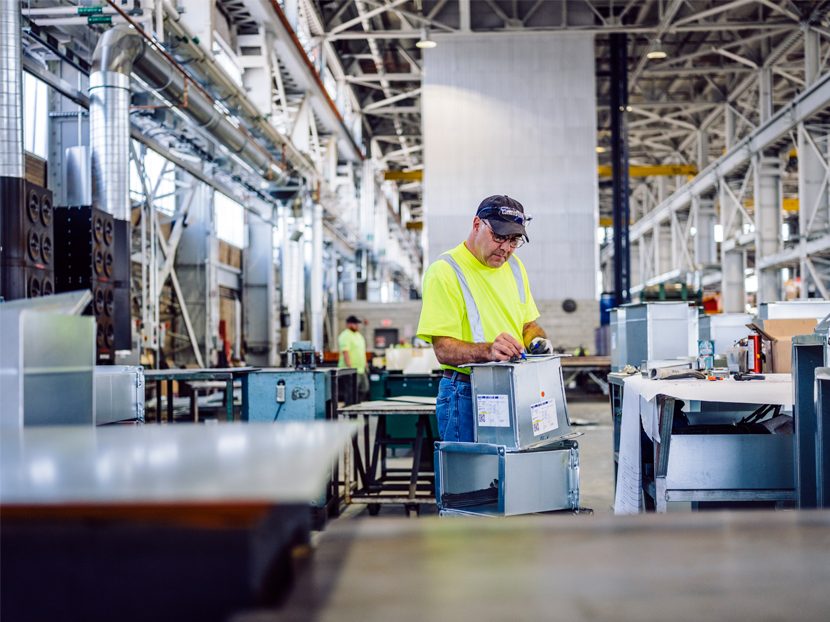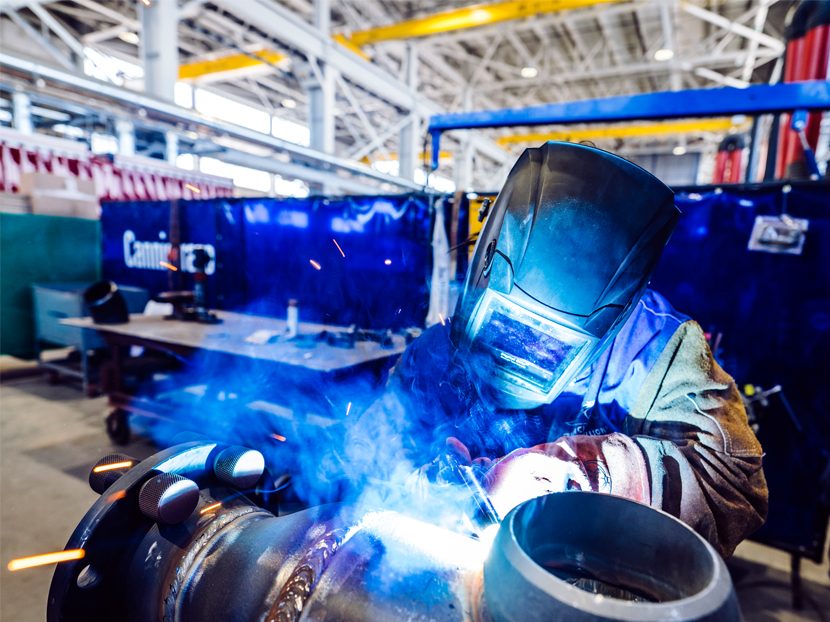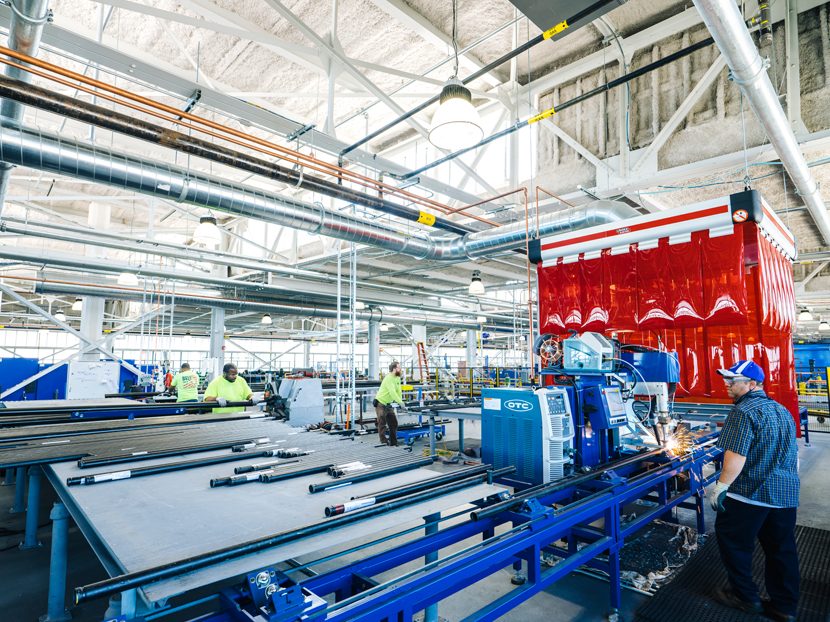Cannistraro’s Lean Approach to Modular Construction
Among many accomplishments, the mechanical contractor opens The FID, a 157,000-square-foot multitrade prefab center.












We have plenty of reasons to choose J.C. Cannistraro as our magazine’s Contractor of the Year. Long-time success? Try more than a half a century in business. Mentor to the next generation of tradespeople? Sure, but the company probably should get credit for bringing up the previous and current generation, too. A great place to work? Mentor to countless numbers of college students? Check and check.
A couple of years ago, the business also underwrote the Plumbing Museum, bringing it to a new home and adding programs and other highlights to this long-standing dedication to the trades.
Cannistraro, one of New England’s largest union mechanical contracting firms, has its roots in the entrepreneurial vision of John Cannistraro Sr., who along with his wife, Rita, as “voluntary secretary,” started the business in 1963. Along the way, the company has expanded from its plumbing and piping origins to include HVAC, sheet metal and fire protection installations, as well as a service division.
Today, the company employs 800, including 600 in the field, with revenue reported well past the $220 million range.
If all this wasn’t enough to write about, then, heck, the company’s headquarters is even in the aptly named Watertown, Massachusetts.
But let’s settle on a couple of related reasons for our choice this year: The firm’s reputation as a leader in modular prefabrication and a very early adopter of construction technology that to too many, unfortunately, still sounds like pie-in-the-sky fantasy.
And much of that commitment to the future of construction is all on display inside the company's latest accomplishment – The FID.
The FID
Last June, Cannistraro celebrated the grand opening of The FID, a 157,000-square-foot fabrication operation for plumbing, HVAC, fire protection and multitrade construction assemblies.
“We recognize the increasing demand for better and smarter construction in the city of Boston, and hope that this new facility will pave the way for more efficient ways to build,” said John Cannistraro Jr., president, at the building’s pipe-cutting opening ceremony. “The FID is not just for us; it is a home for industrial excellence and innovation in the heart of our great city of Boston.”
The building is located in the city’s Seaport District and consolidated the company’s fabrication operations for piping for plumbing and sprinkler systems, heating, ventilation and air-conditioning equipment and sheet-metal duct work that had previously been located in Stoughton, Wilmington and Watertown, Massachusetts.
The ground floor, mainly reserved for sheet metal work, also includes welding, assembly, fabrication and materials storage areas. Flanked on one side by administrative offices, this level also incorporates at-grade and raised truck loading/unloading areas on all four sides of the building.
So gargantuan is the first level that visitors are surprised to find there’s a second floor – and based on the number of stairs we climbed during our tour, the operative word would have to be “second level.” The space is mainly for plumbing and piping work, combining fabrication, staging and cutting areas, a tool room and office/support areas.
But this is also a multitrade facility, too, so on the second level during our visit, we saw hospital headwall units being prefabbed, including not just the medical gas that Cannistraro crews handle, but also space for carpentry and electrical trades to do their work, all with the intention of bringing the set piece to the jobsite for more efficient construction.
“Today’s pace of construction doesn’t allow us to just stick build,” says Dean Allaire, vice president, plumbing and fire protection. “We think this is in the best interest of the project to stick together and figure out the best solution as a team. Everybody’s here doing prefab for projects that all come together at the jobsite, so everyone profits from the space.”
The FID currently employs 100 workers, but certainly has the capacity to house many more.
Kelly McNeill, fabrication manager – plumbing, walked us through The FID. She started out in coordination and was in the process of cycling through other company functions after graduating with a bachelor’s degree and master’s degree in architecture. The next stop was working at the Wilmington prefab site.
“I loved it so much I never left,” McNeill says.
She’s currently overseeing the work done at The FID, and while she rattled off a great amount of job responsibilities to us, her job boils down to overseeing all the fabrication detailing that gets released from the coordination departments. A denizen of Six Sigma, she is currently busy making sure the new site is running at its tiptop.
“I like the hands-on aspect of the work,” McNeill says, “and to be able to work as a team and see the final product.”
Lean construction
Offsite fabrication for mechanical and plumbing installations results in safer, leaner and higher quality projects. Cannistraro looks to fabricate as much as possible, as often as possible, on every project.
That stated goal upon opening The FID was to prefab 100 percent of its work.
We’ve heard construction described more than once as “controlled chaos.” But Cannistraro views its work differently. By bringing the bulk of the work into a controlled environment, every plumbing, piping or sheet metal component can be pre-engineered and installed within a pre-determined time frame.
That can only improve materials management, enable just-in-time delivery and decrease jobsite safety risks. Every piping assembly that is fabricated can get modeled in great detail, spooled, pushed directly to the right equipment and built by licensed craftsmen exactly as specified.
And all this means that a project developer can open a building that much sooner and start collecting a rent check.
It’s easy to see this value proposition when you consider how ludicrous it would be to, say, expect a consumer to buy a car or computer if it were all built outside in all types of weather. If that won’t fly, why should it for construction?
As impressive as The FID is, what goes on behind the scenes is crucial to its operations. An early adopter of lean construction methods and technology-based construction practices, Cannistraro has more than 30 employees working in virtual design and construction across various disciplines. In the field, foremen stay connected with iPads and iPhones to help them manage both their workload and their teams
Jim Fitzgerald, plumbing coordination manager, saw the writing on the wall half a career ago when he was a journeyman plumber for Cannistraro and made the move into coordination when that largely meant drawing with pencils and T-squares.
Fitzgerald eventually picked up some night school classes in the first version of AutoCAD as the company began to make some of its first moves into tech.
Nowadays, Fitzgerald’s department looks to take much of the workload off the jobsite.
“How can we put that into the controlled atmosphere of a fabrication facility,” he adds. “That’s the big questions we ask ourselves everyday.”
“We like to think we're very customer-centric,” Allaire adds. “Of course that means we are hiring and training the best people. But that also means that we’re constantly powering through all the new technologies and software to find the next game changer.”
Like Fitzgerald, Allaire has been in the industry long enough to remember when something as simple as a light table – which allowed contractors to overlay 2D drawings all the better to see discrepancies – was revolutionary.
Of course, that light table has long been replaced with 3D modeling software and state-of-the-art automated welding and cutting machines at old fab shops.
“Construction can be very reactive,” Allaire explains. “So we always say we want to spend more time with proactive activities. We want to plan the work, we want to make sure that we have a roadmap to success. We might be in the virtual world for a year or 18 months modeling in the BIM before we step foot on the jobsite.”
Old hat
While The FID might be “bigger and better,” Cannistraro was fabricating and using the latest tech at its former fab shops. Watertown included approximately 35,000 square feet of general warehouse operations, construction trade tool storage, and fire protection piping prefabrication. The Wilmington facility included approximately 60,000 square feet of heavy industrial space used for welding, piping and plumbing systems prefabrication and modular component assembly. And the Stoughton facility included approximately 30,000 square feet of industrial space used for HVAC sheet metal fabrication operations.
Additionally, the company was outsourcing a trucking yard in South Boston for temporary staging of flatbed truckloads of materials to be delivered to various job sites into the city.
At Cannistraro, prefabrication began with individual lengths of piping preassembled with all associated pipe valves and fittings. Later, assemblies grew into multi-service piping racks, pre-packaged toilet fixtures, HVAC pump skids on pre-poured concrete inertia bases and now multi-trade Pre-Assembled Modules (PAM) including all plumbing and HVAC piping, ductwork and electrical.
We heard and read about plenty of prefab success stories about Cannistraro before our visit, too. That goal of 100 percent prefab made at the opening of The FID? The company is already prefabbing about 85 percent of its piping work right now.
However, The FID puts the company closer to the action since approximately 90 percent of Cannistraro’s projects are within a five-mile radius from the new facility.
“Before we opened The FID, that meant a lot more trucks and deliveries to a job site,” says Christopher J. Meurer, operations manager. “Now, we can consolidate a lot more amongst all of our trades and just have one delivery to a job site because we won’t be coming from three different locations anymore. Plus, we can also make sure that the project foremen are going to The FID and actually seeing what's being built. That way they can have a lot more input. It could easily mean a drive of an hour and a half to go look at something at the old fab shops. So there's definitely been a lot more engagement with The FID.”





